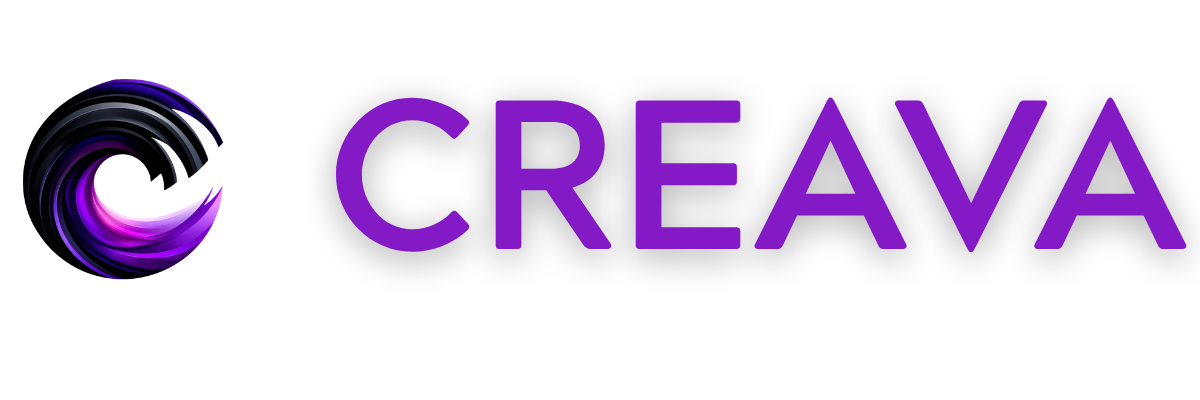From Modernism to Midjourney: Reimagining Le Corbusier Through AI
What if Le Corbusier used a camera instead of a pencil? Discover how Midjourney reimagines modernism through an AI-powered lens.
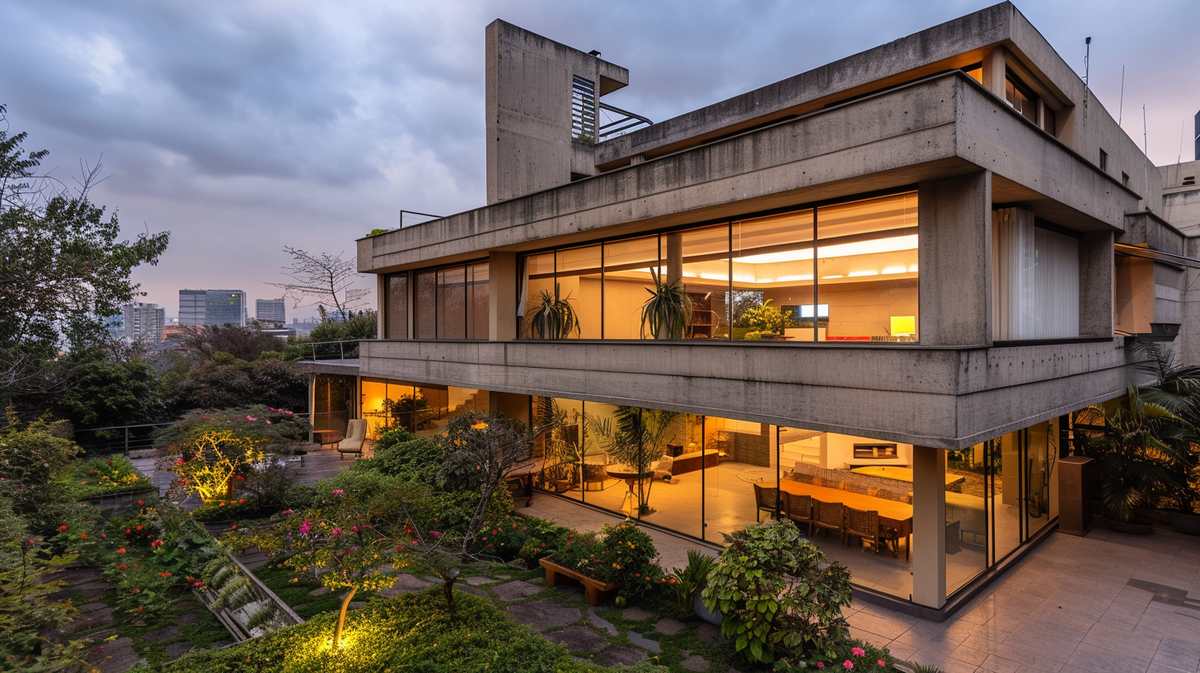
What if Le Corbusier had a camera instead of a drafting pen?
Would his vision of machine-age modernism shift from rigid geometry to soft shadows? Would his buildings, often described as sculptural machines for living, be reimagined through the warmth of golden-hour light and the tactility of a grainy ISO?
We now live in a time when these questions are no longer speculative. Thanks to the convergence of artificial intelligence and image generation, the architectural philosophies of pioneers like Le Corbusier are being rediscovered. They are not rediscovered through hand-drawn blueprints, but through algorithmic eyes. And they are not rendered as distant concept art. They appear as photographs that never required a physical lens.
This exploration is not only about aesthetics. It is about translating spatial philosophy into photographic form. It is about bridging the rigor of modernism with the interpretive power of digital tools. The instruments of the past, ink, drafting boards, and poured concrete, now meet the instruments of today: Midjourney prompts, virtual DSLR settings, and stylization curves.
🔹 A Framework for This Exploration
- We begin by revisiting Le Corbusier’s architectural legacy. His bold ideas, timeless works, and radical ethos defined much of twentieth-century design.
- We then reflect on his philosophical tension with Frank Lloyd Wright, grounding our perspective in two opposing yet complementary visions of architecture.
- Next, we explore Midjourney’s stylization scale, moving from RAW realism to hyper-stylized abstraction, and examine how this setting shapes architectural rendering.
- Finally, we step into the role of photographer. We study ISO, aperture, lenses, and shutter speed as applied to Midjourney prompts, transforming generative art into images that approach photographic documentation.
This is not only a tribute to a modernist mind. It is also a study in reinterpretation. A fusion of discipline and dream. A place where AI does more than simulate a camera. It redefines how we see.
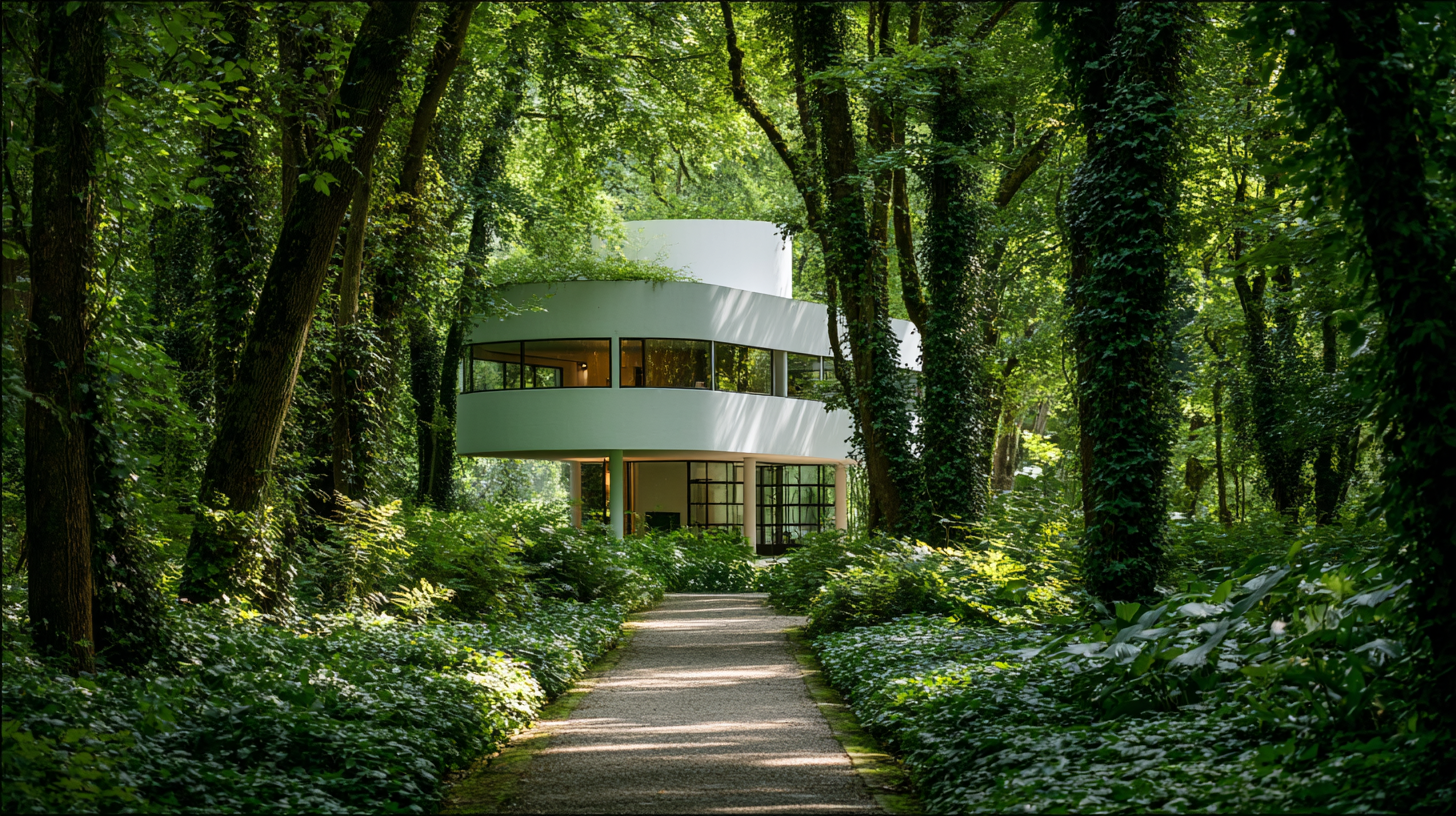
🏛️ II. Le Corbusier: A Life in Concrete
Born Charles-Édouard Jeanneret in 1887, Le Corbusier was never content with the world as it stood. He imagined what it might become. Swiss by birth and French by choice, he embraced modernism as conviction, not fashion. He saw architecture as more than visual craft. He saw it as a social contract.
At a moment when cities were expanding faster than they could care for people, he envisioned dwellings not as extravagant symbols of wealth but as “machines for living in”. He believed form should follow function. Homes, like well-designed machines, ought to serve daily needs efficiently, thoughtfully, and precisely (First in Architecture).
Where others saw concrete as cold and impersonal, Le Corbusier saw potential. He embraced béton brut, or raw concrete, to create surfaces that revealed structure rather than concealing it (Docomomo US). For him, these surfaces were honest. They displayed the patterns and textures of their forms and construction.
His works Villa Savoye, Unité d’Habitation, and Notre Dame du Haut became manifestos of a new way to live and think. In these structures, modular logic, open plans, and the tension between solid and void spoke louder than decoration.
His approach was never just about buildings. It was philosophical. He argued that architecture must not only house life. It must enhance it.
🧱 Five Points of a New Architecture
In 1926, Le Corbusier formalized his vision into a doctrine known as the “Five Points of Architecture.” These were not just stylistic guidelines. They were his blueprint for modern life. Together, they offered a new vocabulary for how buildings should function, feel, and interact with their surroundings.
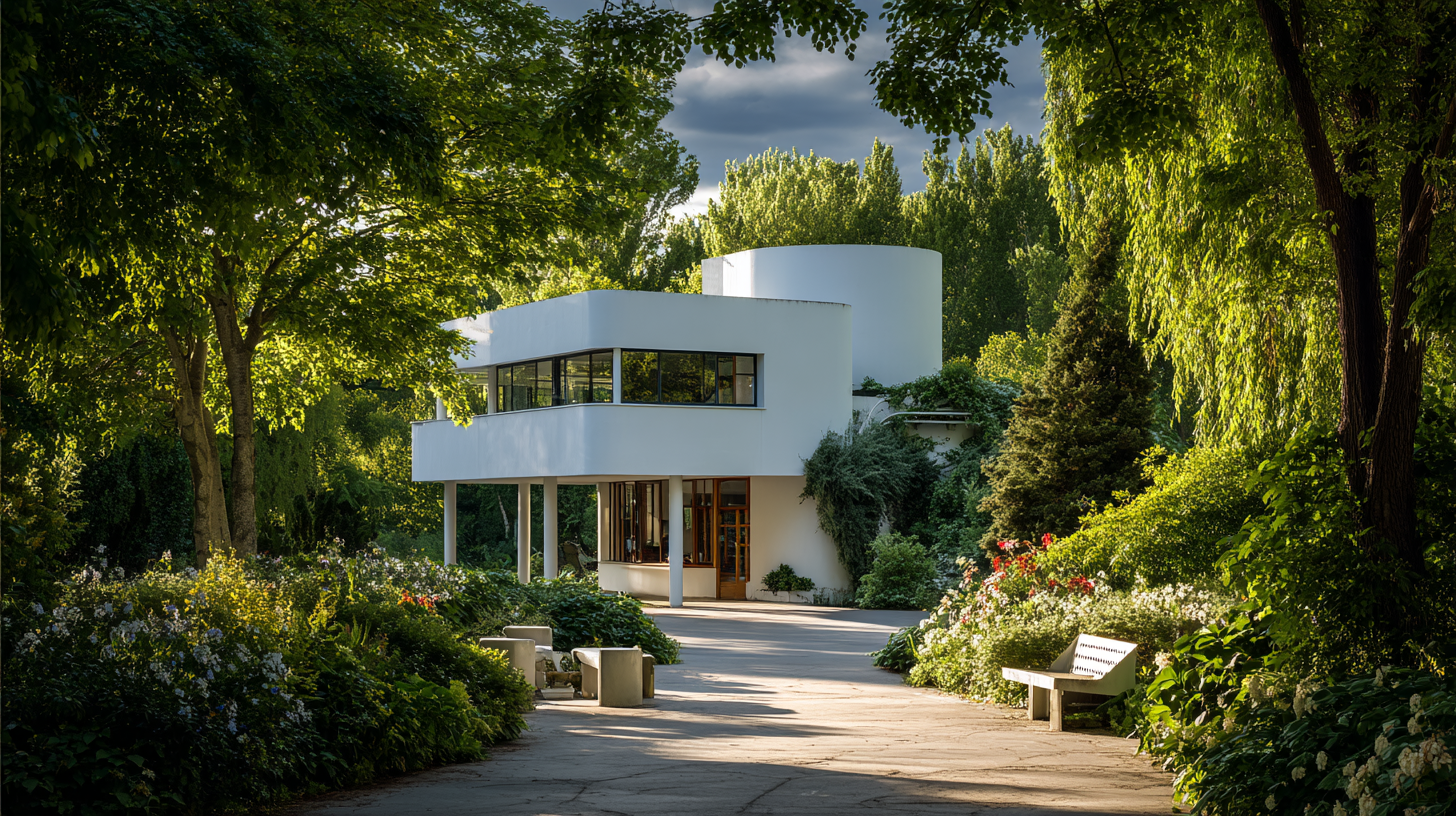
1. Pilotis (Support Columns)
Le Corbusier began with the ground itself. Instead of anchoring buildings with heavy, load-bearing walls, he lifted them on slender support columns known as pilotis.
This single move changed everything. By raising the structure, the earth beneath was liberated. Gardens could flow under a home. Light and air could move freely. Space became continuous rather than divided.
Pilotis offered more than practical benefits. They symbolized freedom from tradition. In cities where land was dense, lifting a building opened new possibilities for circulation and community. In homes like the Villa Savoye, the floating form became a statement. The house seemed to hover, weightless, as if modern life had finally broken free from the ground’s constraints.
The idea was radical for its time. Most buildings were still rooted in masonry traditions that tied structure to weight. Le Corbusier’s columns created an architecture of openness. They turned the base of the building into a living part of its environment rather than a barrier against it.
Pilotis became one of the clearest expressions of his vision of modernism. They were rational. They were efficient. And they were poetic. By lifting the body of architecture into the air, Le Corbusier offered a vision of buildings that belonged not only to the earth but also to the sky.
📸 Midjourney Prompt:"modernist villa on concrete pilotis, elevated structure, clean lines, minimalist landscape, Leica DSLR, 35mm lens, --v 6 --ar 3:2 --s 50"

2. Free Façade
Once Le Corbusier lifted the structure onto pilotis, the walls no longer had to carry weight. The supports were now inside. That simple shift unlocked one of the most revolutionary ideas in modern design: the free façade.
The exterior of the building was no longer bound by structural necessity. It could become canvas. It could be made of glass, plaster, or concrete. It could be open or closed, smooth or textured. The face of the building became expressive rather than structural.
This principle allowed architecture to move past tradition. Walls were no longer thick, immovable barriers. They became light skins, surfaces that could breathe, frame, and filter. Architects could now design facades that served visual poetry as much as physical shelter.
Think of Villa Savoye. Its clean white façade wraps around the house like a sculptural ribbon. The walls are pure expression. They frame horizontal bands of glass. They emphasize lightness instead of mass. Without the burden of structure, the façade could finally become art.
The free façade also shaped the future of urban buildings. It encouraged curtain walls, modular grids, and experiments with transparency. It showed how technology could liberate not only space but also the identity of a building.
For Le Corbusier, this was more than efficiency. It was philosophy. A free façade reflected freedom of thought. It proved that modern life did not need to be trapped in stone. It could be flexible, adaptable, and alive to change.
📸 Midjourney Prompt:"Le Corbusier-inspired free façade design, brutalist exterior, large glass panels, minimalist symmetry, ISO 200, golden hour, --v 6 --s 75 --ar 16:9"

3. Free Plan
When Le Corbusier introduced his Five Points of Architecture in 1926, one of the most radical principles was the free plan. By shifting structural support onto pilotis, the weight of the building no longer pressed onto interior walls. Instead, walls could become partitions, flexible and movable, or disappear entirely. This simple but revolutionary idea gave architects freedom that architecture had never seen before.
The free plan liberated the interior. For centuries, masonry construction had dictated where rooms began and ended. In Le Corbusier’s vision, function shaped form. Rooms were no longer trapped by heavy stone or brick. They could follow light, circulation, and human needs. This new flexibility meant that a house was no longer a fixed box but a living framework.
In the Villa Savoye, the free plan comes to life. Visitors move through a sequence of spaces that flow naturally, guided by light and orientation. Walls act not as barriers but as gentle dividers.The living room, the ramp, and the roof garden are all part of a continuous experience. What was once rigid now feels open, dynamic, and adaptable. The home seems designed to grow with its inhabitants rather than confine them.
Over time, the concept of the free plan evolved into what became widely known as the open plan. The difference lies in philosophy and application. The free plan was a structural innovation, a liberation of architecture from load-bearing walls. The open plan became a stylistic and cultural movement, especially in the twentieth century. It described interiors where walls were intentionally minimized, where kitchens, dining rooms, and living rooms merged into one continuous space. The loft apartment and the modern office both carry its legacy.
The distinction is subtle but essential. The free plan created the possibility of flexibility. The open plan embraced that possibility and turned it into lifestyle. One was born from engineering innovation. The other grew from cultural desire. Together, they reshaped how we live, work, and imagine space.
📸 Midjourney Prompt:"open floor plan, concrete walls, modular space, exposed structure, natural light flooding from skylights, 85mm lens, shot from above --v 6 --ar 3:2 --s 60"

4. Banded Windows
When Le Corbusier outlined his Five Points of Architecture, one of his most radical ideas was the introduction of what he called banded windows. These long horizontal openings stretched across the façade, breaking free from the vertical rhythm that had dominated architectural design for centuries.
Instead of small punctured holes in thick masonry walls, continuous bands of glass flowed across the structure. This was not merely a stylistic change. It was a rethinking of light, vision, and space.
Banded windows changed the experience of living. Interiors were suddenly bathed in natural light that spread evenly across a room. Views were no longer framed as isolated scenes. They became panoramic horizons, turning the landscape into a living mural. For the first time, a window was more than an aperture. It became a continuous ribbon of vision that joined the interior and exterior in one gesture.
Over time, banded windows came to be more widely known as ribbon windows. The new term captured their identity as sleek, modernist bands of glass that sliced across facades with precision. Ribbon windows soon became a defining hallmark of twentieth-century architecture, embraced by the International Style and the Bauhaus.
In the Villa Savoye, this principle defines the house. A continuous horizontal band of glass wraps the structure, dissolving the boundary between inside and outside. Light floods the interior in long stretches. Fields and skies outside become part of the daily experience of the home. What was once wall becomes horizon.
The idea was simple yet transformative. Windows were no longer fragmented openings. They became continuous lines of connection. For Le Corbusier, the banded window and its later evolution as the ribbon window were not only glass. They were a philosophy of openness, equality, and horizon.
📸 Midjourney Prompt:"brutalist house with horizontal ribbon windows, mid-century design, natural light casting linear shadows on concrete, 50mm lens, shot at noon --v 6 --s 70 --ar 16:9"

5. Roof Gardens
Le Corbusier’s final point lifted life upward. Flat roofs, once seen as wasted surfaces, became living spaces. He imagined them as roof gardens, green, restorative, and reflective.
The principle was both practical and poetic. By reclaiming the roof, he returned to nature the ground space taken up by the building. What was lost to construction could be restored above. A garden on the roof was not only decoration. It was balance.
These gardens changed the experience of architecture. They offered places of retreat where air, light, and vegetation met the structure. In dense cities, a roof garden gave residents direct access to greenery and sky. It was a new form of breathing room, a vertical escape.
In the Villa Savoye, the roof garden completes the house’s dialogue with the landscape. It connects modern living to nature without leaving the building. The garden softens the concrete, adds texture, and restores a sense of organic life.
The idea also anticipated future concerns. Le Corbusier recognized that cities needed spaces for health, rest, and renewal. By moving gardens onto roofs, he offered a vision of architecture that could heal as well as house. Today, this principle lives on in the widespread adoption of green roofs, sustainable design, and eco-architecture.
The roof garden was more than a technical solution. It was philosophy. It reminded the modern city that humans need more than walls. They need sky. They need soil. They need places where architecture and nature live together.
📸 Midjourney Prompt:"rooftop garden on brutalist architecture, concrete planters, open sky, vegetation integration, shot at sunset, 35mm film look, --v 6 --s 100 --ar 4:3"

As these five principles reshaped the modern skyline, another voice across the Atlantic was planting a different kind of seed—one rooted not in concrete, but in the natural world.
To understand how these visions converged—and diverged—it helps to step into the philosophy of Frank Lloyd Wright, whose organic ideals offered a striking counterpoint to Le Corbusier’s machine-age rationalism.
👉 Midjourney Meets Wright: AI, Architecture, and the Soul of Design
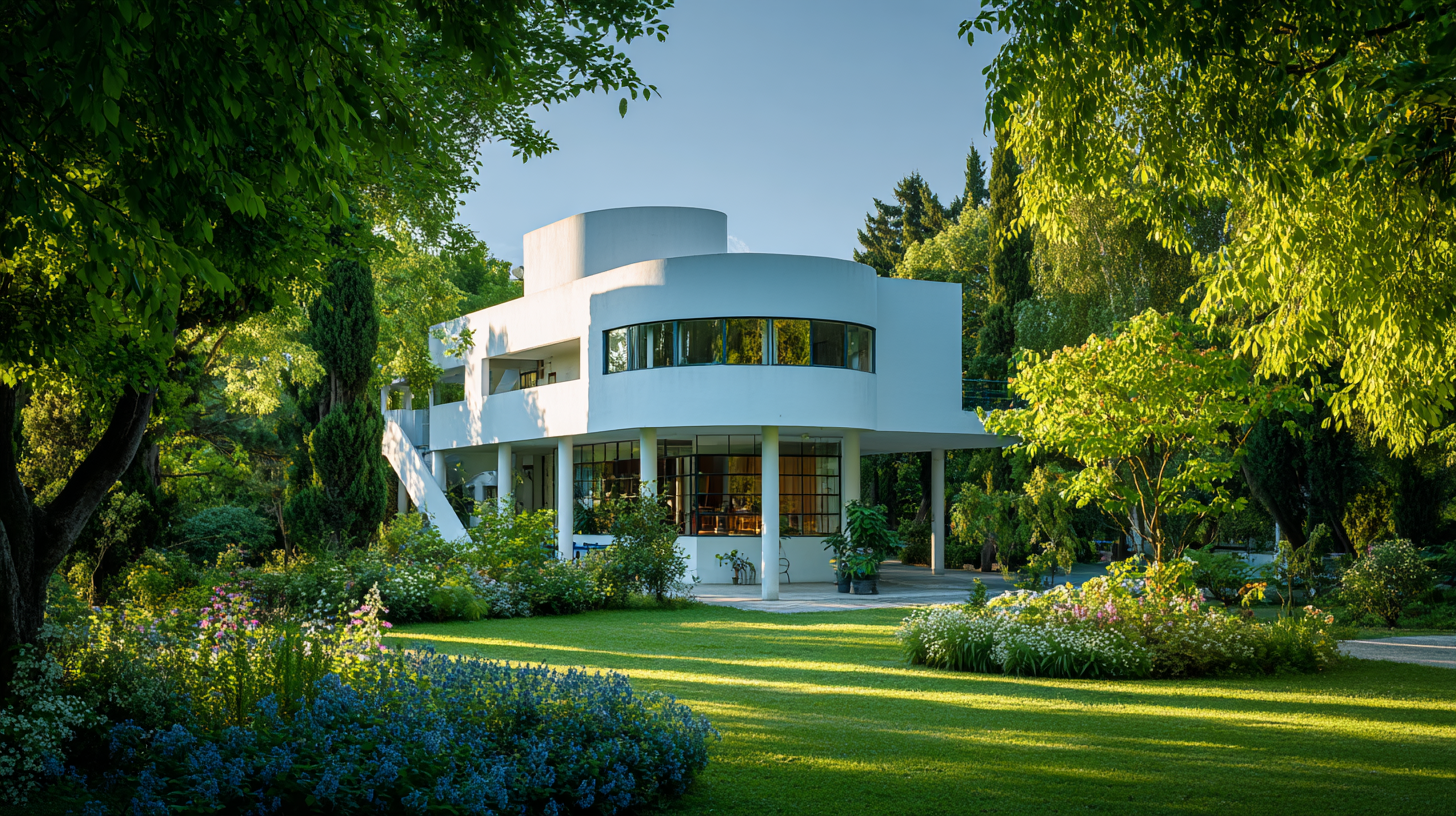
🧭 III. Le Corbusier and Frank Lloyd Wright: A Dialogue Across Oceans
While Le Corbusier was imagining homes as machines for living, Frank Lloyd Wright was teaching them to breathe.
These two giants of modern architecture shared a century, but not a sensibility. One looked to the rhythms of nature, the other to the logic of industry. One curved like a hillside, the other aligned like a grid. And yet, beneath those differences, both sought the same truth: to design spaces that elevate the human experience.
🏛️ Philosophy in Tension
Wright leaned into the organic. Le Corbusier embraced the mechanical. Their contrasts were not simply visual; they were philosophical. Each saw architecture as a reflection of how life should be lived.
Wright believed architecture should follow nature.
🟢 Nature-led, rooted in the land, shaped by the environment.
He drew inspiration from the forms of trees, rivers, and the geometry of landscapes. In works like Fallingwater, stone rises from the rock, and water flows through the home itself. His buildings were conceived as living organisms, designed to grow naturally from their surroundings.
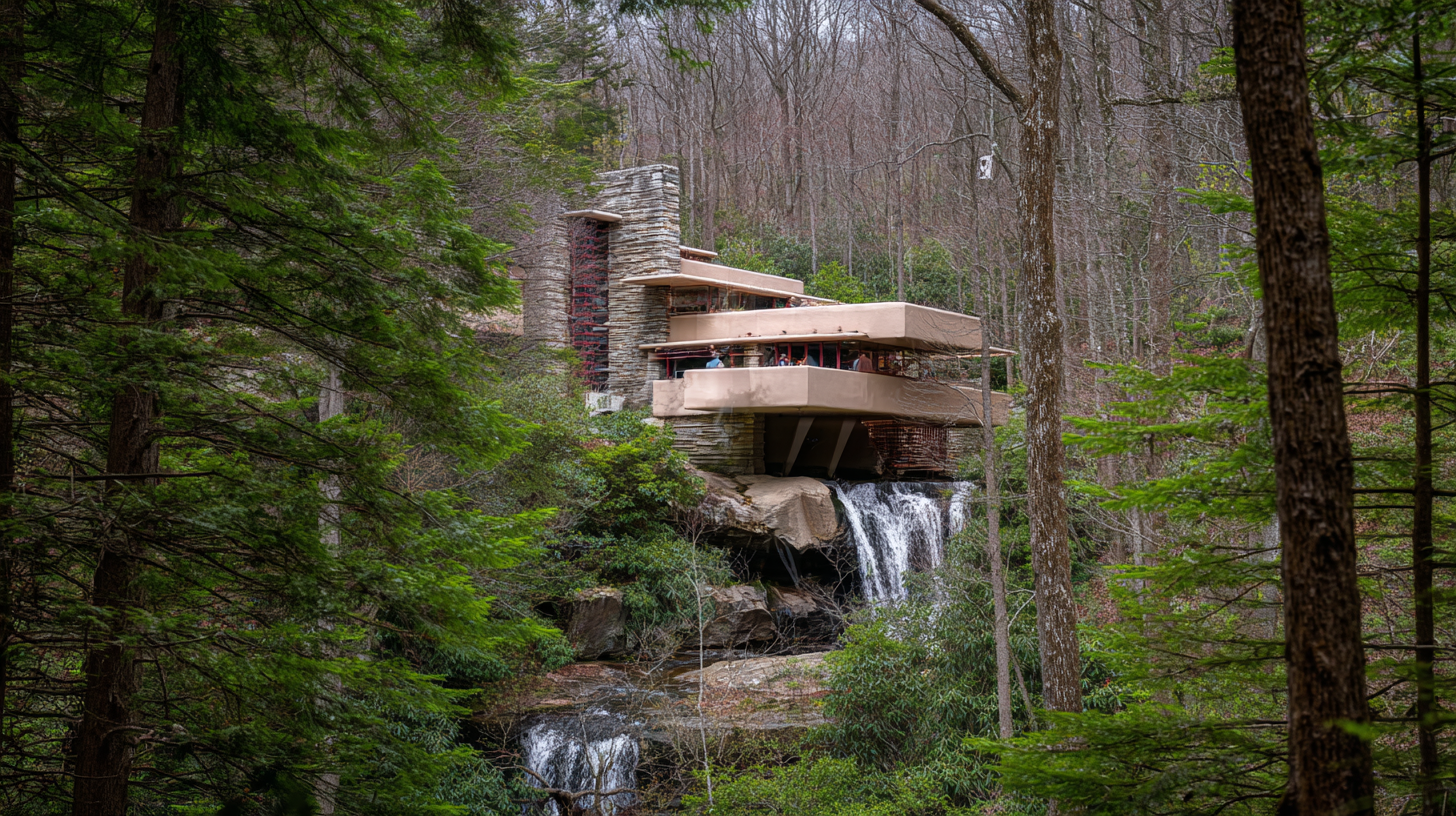
Le Corbusier believed architecture should follow reason.
⚙️ Machine-led, engineered, and guided by logic.
He believed that buildings should serve human needs through clarity, precision, and efficiency. In his Five Points of Architecture, structure became universal and adaptable. His vision of the home as a machine for living reflected his desire to create harmony between human proportions and industrial innovation.
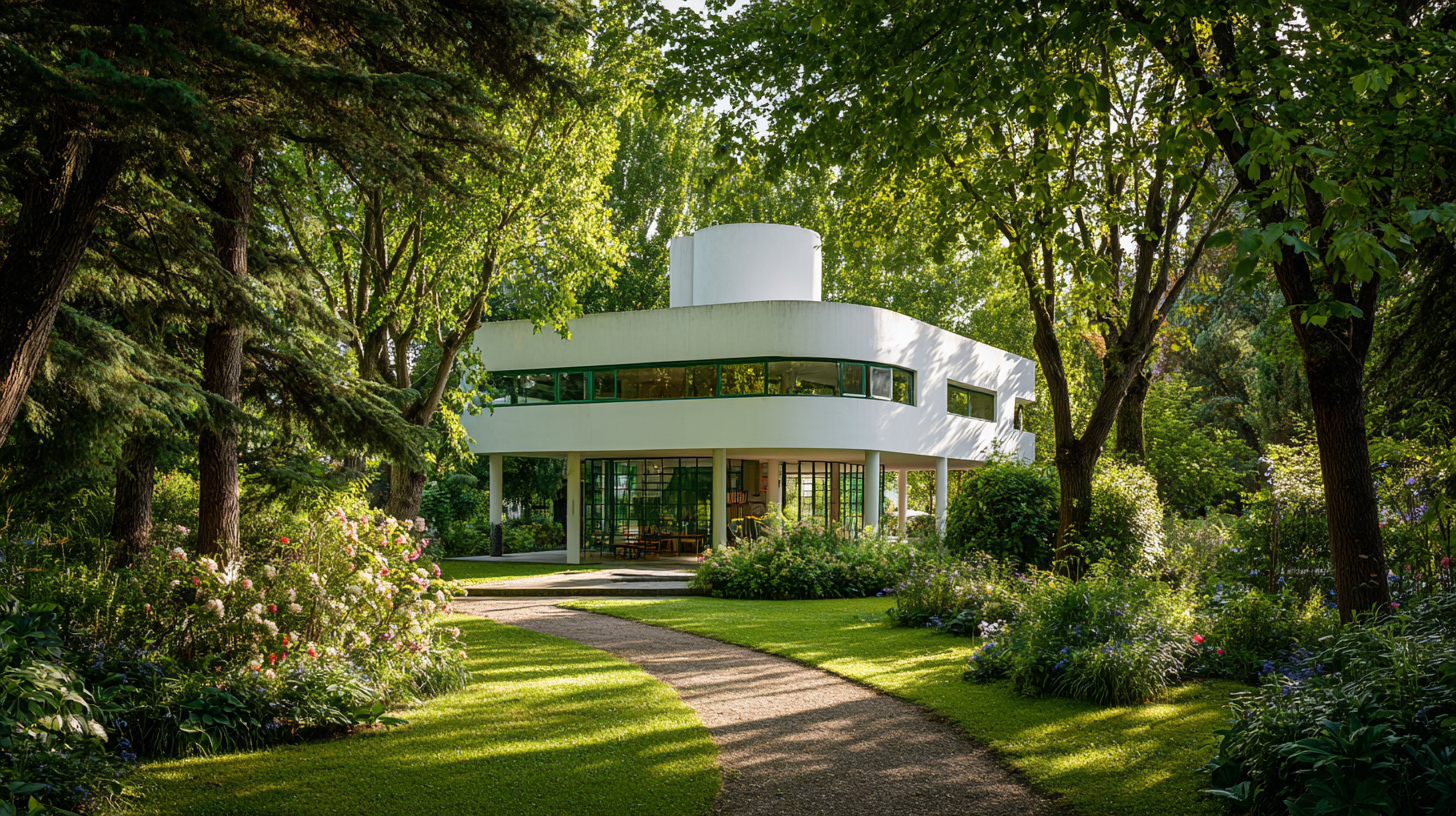
🌿 Form and Material
Wright shaped buildings with soft, organic curves.
🟢 Inspired by trees, hills, and water.
He worked with materials sourced from the land itself, using stone, timber, and local clay, believing that every building should belong to its environment. His style, known as Organic Architecture, sought unity between form and nature.
Le Corbusier shaped buildings with bold, geometric forms.
⚙️ Grids, cubes, and straight lines.
He favored concrete, steel, and glass, materials that embodied modern progress and universal application. His fascination with proportion led him to create the Modulor System, a mathematical approach to scale based on human measurements and the golden ratio.
💡 Emotion vs. Logic
Wright viewed the home as a living sculpture.
🟢 Emotional, personal, and handcrafted.
He wanted architecture to feel alive, to express individuality and warmth. Each project was shaped by empathy — an understanding of how people move, rest, and connect within a space.
Le Corbusier saw architecture as a system of clarity.
⚙️ Efficient, logical, and functional.
He pursued order over ornament, believing beauty could emerge from proportion and precision. His buildings were not handmade artifacts but frameworks for modern life.
🎨 A Conversation in Contrast
When reimagined through creative tools like Midjourney, the philosophies of Frank Lloyd Wright and Le Corbusier begin to overlap. The organic lines of Wright meet the engineered precision of Le Corbusier. One softens the other. One defines the structure, the other gives it soul.
Artificial intelligence does not erase their ideas. It extends them. It allows us to see how two seemingly opposing minds can coexist within a single frame. The language of nature and the language of machines start to harmonize. The grid meets the curve. The concrete meets the stream. What once stood apart begins to converse.
In this dialogue, we find something timeless. Great design has never belonged to one philosophy. It lives in the space between them. It thrives in the tension between emotion and order, between the natural and the constructed. The warmth of Wright’s materials speaks to the same clarity that Le Corbusier found in proportion and geometry. Their visions, once divided by oceans, now meet in the digital realm.
Through the lens of AI, architecture becomes more than a physical act. It becomes interpretation. Midjourney turns a prompt into perspective, a phrase into light, and an idea into form. It merges Wright’s belief in organic flow with Le Corbusier’s faith in structural logic. Together, they reveal what modern design still seeks: a balance between feeling and function, intuition and innovation.
This fusion reminds us that architecture, at its best, is not a contest between philosophies. It is a conversation between worlds. Between what we build and what we feel. Between how we shape space and how space, in turn, shapes us.
🎨 IV. Midjourney’s Stylization Spectrum: RAW to 250
In Midjourney, the --s parameter—short for stylization—does more than adjust aesthetic. It determines how strictly the AI follows your prompt versus how much creative freedom it takes.
At one end of the spectrum is RAW realism. At the other, interpretive flourish.
Understanding how this setting influences output is essential—especially when working with architecture, where form, material, proportion, and light demand accuracy.
Think of stylization like a camera lens filter:
- The lower the value, the more literal and grounded the result.
- The higher the value, the more expressive, abstract, or cinematic the output becomes.
🔍 What is Stylization?
Midjourney’s stylization range extends from --s 0 to --s 1000 (depending on model version). But for controlled, architecture-friendly rendering, the sweet spot lies between:
--s 0→ Hyper-literal interpretation--s 50–100→ Naturalistic with subtle creative variation--s 150–250→ Expressive, mood-driven, often painterly
🎯 Why Stylization Matters in Architecture
In architectural work, stylization directly impacts clarity. The higher the value, the more likely you’ll see:
- Blurred edges
- Skewed proportions
- Unrealistic materials
- Dreamlike lighting
While this works for conceptual design and storytelling, it can distract from technical realism—which is crucial for Midjourney users emulating DSLR-style output or studying brutalist geometry.
For most use cases involving built environments, lower to mid-range values (--s 0–100) are ideal.
Best fit for:
- Architectural photography simulation
- Brutalist and mid-century renderings
- Texture and lighting studies
- Editorial presentation or mockups
✏️ Prompt Progression: Stylization in Action
Using a single base prompt, let’s see how results evolve with increasing stylization:
Prompt Base:"Le Corbusier-inspired brutalist villa, exposed concrete, ribbon windows, rooftop garden, golden hour, DSLR 35mm lens, --v 6"
--s 0
Hyper-realistic. Crisp geometry, neutral color tone. Feels like a real photograph.

--s 0, Midjourney renders a hyper-realistic brutalist villa — sharp lines, natural lighting, and photographic clarity evoke the feel of real architectural photography.--s 50
Still accurate, but with softer contrast and enhanced ambiance. Ideal for editorial work.

--s 100
Richer lighting effects, slightly stylized texture. Forms may begin to romanticize realism.

--s 150
Creative interpretation begins. Proportions may shift, lighting becomes cinematic.

--s 250
Fully stylized. Useful for concept art or storytelling, but less practical for architectural fidelity.

✅ Recommended Stylization Settings
Photo-real architectural studies--s 0–50
Balanced realism with expressive mood--s 75–100
Conceptual and artistic development--s 150–250
For architecture inspired by Le Corbusier, working within the --s 50–100 range strikes the best balance—delivering accuracy in structure while giving enough space for atmosphere and intent.
📷 V. Midjourney as a Photographer: Mastering the Virtual DSLR
The difference between a render and a photograph lies in how it’s framed.
Midjourney may be an AI model, but its output can be deeply photographic—if you know how to guide it. When prompts include camera-specific language like focal length, ISO, aperture, and shutter speed, the AI responds with perspective, depth, and lighting that mimic real-world lens behavior.
In architectural visualization, this distinction is vital. It turns static generative art into something that feels lived-in—something that could have been shot on-location.
🔍 Why Use Camera Language in Midjourney?
A camera does more than record. It chooses. It frames. It translates the world into mood, story, and light. Midjourney, though not bound by lenses or physics, listens to the same visual language. When you speak like a photographer, the AI responds like one.
Describing a building as shot on a 35mm lens or captured at ISO 100 tells the model something vital. You are not just defining a subject. You are defining a point of view.
A 35mm lens suggests intimacy and realism. A shallow depth of field implies focus and emotion. ISO 100 speaks of natural light, of quiet clarity. Even words like backlit, golden hour, or soft focus cue the model to compose with intent.
You are giving it more than geometry. You are giving it atmosphere.
This approach turns a prompt from technical into cinematic. From static to alive.
The result?
Not just an image. But a moment.
Not just a render. But a photograph.
It feels believable. It holds weight. It suggests someone was there to capture it.
Using camera language in your prompts invites Midjourney to think like a director, a cinematographer, or a stills photographer. It draws on visual memory, lighting principles, and spatial depth. It adds the kind of detail that makes an image linger.
This is how you move from picture to presence.
From idea to emotion.
So next time you prompt, speak like you're behind the lens. Let the AI know how you want the story to be seen, not just what you want to show.
Because when the image feels real, the vision becomes unforgettable.
🔭 Lens Types and Focal Lengths
Every lens tells a different story. It shapes how we see a space, how we frame emotion, and how we guide attention. In Midjourney, using lens language helps you influence not just what is seen, but how it is experienced.
Here’s how to choose your lens based on the mood and message you want to convey.
📷 35mm – Street Perspective
Wide and grounded, the 35mm lens brings viewers into the scene without overwhelming them. It captures the world with a sense of proximity and realism, offering just enough breadth to show context while keeping the subject clear and strong.
Perfect for:
- Urban exteriors
- Architectural walk-ups
- City blocks and full-building context
- Everyday realism with slight cinematic pull
This focal length is ideal when you want your render to feel natural yet composed, like it was taken during a walk through the neighborhood. It shows space as it lives and breathes, capturing scale and setting with quiet confidence.
In Midjourney, adding shot on 35mm lens tells the AI to honor authentic perspective. It results in images that feel rooted, balanced, and believable. They appear as if taken with a keen eye on a street corner just before golden hour.
Use 35mm when you want your scene to feel honest, lived-in, and approachable, without losing structure or impact.
📸 Prompt:"Le Corbusier-inspired brutalist apartment block, wide shot, street-level perspective, 35mm lens, shot at noon, --v 6 --ar 3:2 --s 60"

📷 85mm – Architectural Portrait
Use the 85mm lens when you want to treat a building like a subject in a portrait.
It brings detail forward. It frames elements with clarity and poise. The result feels intimate without bending or stretching proportions.
This focal length compresses depth. It pulls foreground and background closer together. That compression highlights ornament, material texture, and crafted joinery. Windows, cornices, doorways, and façade details read with new importance.
It also favors a shallower depth of field. Use that to isolate a detail from its context. Let light and surface speak while the rest of the scene recedes softly. This is perfect for editorials, product shots of architectural elements, and portfolio images that ask the viewer to study instead of skim.
In Midjourney, adding shot on 85mm lens nudges the AI toward a composed, focused aesthetic. Pair it with camera notes like f1.8 or tight crop to emphasize intimacy and texture. Pairing with golden hour or soft side light will heighten material richness and shadow subtlety.
Choose 85mm when you want the viewer to feel close, to notice, and to linger.
📸 Prompt:"Villa Savoye, modernist facade, clean lines, shot on 85mm lens, ISO 100, f/11, early morning light, --v 6 --ar 4:3 --s 50"

📷 16mm: Dramatic Angles
The 16mm lens is all about scale, distortion, and drama. It stretches perspective, exaggerates depth, and turns even simple spaces into bold visual statements.
This ultra-wide focal length is perfect for scenes that demand intensity. Use it when you want to make a room feel cavernous, a hallway seem endless, or a structure rise with towering force. In brutalist architecture, it emphasizes mass, weight, and raw geometry.
In interior design, it can make compact spaces feel open or turn ordinary rooms into visual playgrounds. With the right angle, walls lean, ceilings soar, and lines converge with powerful momentum.
Pair it with camera terms like low angle, wide interior shot, or extreme perspective in Midjourney prompts. This tells the AI to push boundaries, stretch lines, and create images that feel kinetic and unapologetically bold.
The 16mm lens doesn’t whisper. It shouts. Use it when you want to impress, confront, or challenge the viewer’s sense of space. It is less about subtlety and more about impact.
📸 Prompt:"Brutalist concrete interior, spiral staircase, low angle, 16mm wide-angle lens, high contrast shadows, --v 6 --ar 9:16 --s 75"

🌤️ Aperture, ISO, and Shutter Speed
These settings are the unsung heroes of architectural storytelling. Each affects clarity, light, and emotion.
🌀 Aperture (f/1.4 – f/16)
f/1.4: Shallow focus, blurred backgroundf/11: Balanced sharpnessf/16: Deep focus, everything in view
📸 Prompt:"Concrete courtyard, depth-focused composition, f/11, golden hour, soft reflections, --v 6 --s 70"

🌡️ ISO (100 – 800)
ISO 100: Clean, crisp daylight shotsISO 400–800: Grainier, nostalgic or cinematic feel
📸 Prompt:"Modernist rooftop, ISO 400, soft light fog, early morning haze, brutalist tone, --v 6 --ar 16:9 --s 60"

⏱️ Shutter Speed (1/250 – 1/15)
1/250: Sharp detail, bright sunlight1/60: Ambient light balance1/15: Motion blur or dim light scenes
📸 Prompt:"Interior staircase, motion blur, shutter speed 1/15, ambient lighting, handheld look, concrete texture, --v 6 --ar 3:2 --s 80"

✏️ Building the Prompt: DSLR as a Language
Treat Midjourney like a camera assistant. Describe the scene as you would during a real shoot.
📷 Prompt:"Le Corbusier-style pavilion, rooftop terrace, 35mm lens, ISO 100, f/8, shutter speed 1/250, strong midday sun, sharp architectural lines, --v 6 --ar 3:2 --s 50"

📸 Prompt:"Brutalist cultural center, dusk ambiance, 85mm lens, ISO 400, f/2.8, long shadows, soft focus background, --v 6 --ar 4:3 --s 100"

This level of photographic detail transforms generative outputs into credible compositions. It’s not about tricking the AI—it’s about speaking its visual language with the nuance of a photographer’s eye.
📸 VI. Sample Prompts + Result Analysis
Understanding how stylization, lens type, and camera settings affect Midjourney’s output isn’t just theory—it’s visual practice.
In the following examples, we use a consistent architectural base inspired by Le Corbusier and modify individual variables to observe how the results shift in realism, emotion, and depth.
🏠 Prompt Base
"Le Corbusier-inspired brutalist villa, exposed concrete, rooftop garden, ribbon windows, golden hour lighting, –— style raw --v 6"
🎛️ 1. Stylization Test
Camera settings remain the same. Only stylization changes.
--s 0
📸 Prompt:35mm lens, ISO 100, f/8, shutter speed 1/250, --ar 3:2 --s 0
✅ Hyper-literal. Crisp geometry, neutral tone, daylight shadows. Ideal for technical documentation.

--s 50
📸 Prompt:35mm lens, ISO 100, f/8, shutter speed 1/250, --ar 3:2 --s 50
✅ Slight warmth. Subtle cinematic tone, still grounded in realism. Suitable for editorial visuals.

--s 100
📸 Prompt:35mm lens, ISO 100, f/8, shutter speed 1/250, --ar 3:2 --s 100
✅ Creative expression. Stronger grading and mood. Textures become expressive.

--s 250
📸 Prompt:35mm lens, ISO 100, f/8, shutter speed 1/250, --ar 3:2 --s 250
⚠️ Highly stylized. Abstract form and light. Great for moodboards, less so for structure.

🔭 2. Lens Variation Test
We hold stylization at --s 60 and test three focal lengths.
35mm Lens
📸 Prompt:35mm lens, f/11, ISO 100, --s 60
🔎 Balanced view. Captures full structure and environmental context.

85mm Lens
📸 Prompt:85mm lens, f/11, ISO 100, --s 60
🔎 Tighter framing. Great for facade studies and architectural portraits.

16mm Lens
📸 Prompt:16mm wide-angle lens, f/11, ISO 100, --s 60
🔎 Exaggerated scale. Powerful for dramatic interiors—requires restraint for realism.

🌤️ 3. ISO and Lighting Mood Test
Composition and lens remain unchanged. ISO is adjusted to simulate different lighting moods.
ISO 100 – Daylight
📸 Prompt:35mm lens, f/11, ISO 100, shot at noon, --s 50
💡 Crisp detail. Ideal for showing structural form in clear conditions.

ISO 400 – Overcast
📸 Prompt:35mm lens, f/11, ISO 400, overcast sky, --s 50
💡 Softer tones. Slight grain, muted palette. Editorial or reflective scenes.

ISO 800 – Cinematic Low Light
📸 Prompt:35mm lens, f/2.8, ISO 800, sunset lighting, handheld film style, --s 75
💡 Nostalgic atmosphere. Visible grain, shadow detail, emotional depth.

📊 Summary
- Stylization (
--s)--s 50–100: Best balance for realism with character--s 0: Documentation accuracy--s 250: Artistic abstraction - Lenses
35mm: Full context85mm: Detail and portrait16mm: Drama and interiors - ISO Settings
100: Daylight clarity400: Filmic mood800: Cinematic grain
🧠 Takeaway
When rendering Le Corbusier-inspired architecture, Midjourney becomes more than a design tool—it becomes a visual language. By fine-tuning stylization and applying DSLR logic, your results feel thoughtful, cinematic, and editorially polished.
To explore Le Corbusier’s original architectural philosophy, visit the Fondation Le Corbusier, where his sketches, models, and preserved residences reveal the rigor behind the vision.
🌐 VII. Applying the Craft: Design, Documentation, and Visual Storytelling
What began as a blueprint now becomes a moodboard.
AI-generated imagery isn’t just for play—it has practical value for professionals across creative industries:
🧱 For Architects
Use Midjourney to explore conceptual massing, lighting studies, or site testing. Combine stylization and camera logic to simulate on-site photography, well before a building is realized.
🎨 For Designers
Integrate photorealistic renders into presentations, websites, or moodboards. Generate variants based on light, materiality, and form in minutes—not weeks.
📸 For Visual Artists and Photographers
Midjourney’s DSLR logic allows you to experiment with framing, composition, and ambiance. It’s not about replacing the lens—it’s about learning how it sees.
🧑💼 For Creative Teams
Use prompts and visuals as collaborative tools. Refine client direction through shared imagery. Align mood and material across disciplines.
From machine-age architecture to machine-assisted imagination, we are now equipped with tools Le Corbusier could only have dreamed of—tools that let us document not what is, but what could be.
🧭 VIII. Conclusion: Le Corbusier Revisited Through the Lens of Tomorrow
Le Corbusier once wrote,
“Architecture is the learned game, correct and magnificent, of forms assembled in the light.”
A century later, that light comes not only from the sun but from the screen—cast by pixels, parsed by models, and composed by prompt.
This post has traced a line through time—from the rigid geometries of modernism to the flexible renderings of artificial intelligence. We’ve seen how the Five Points of Architecture still resonate when interpreted through stylization settings. How the tension between Le Corbusier and Frank Lloyd Wright plays out not just in stone, but in light and lens.
We’ve explored how to craft Midjourney prompts with a photographer’s eye:
- Selecting the right lens to guide perspective
- Tuning ISO and aperture to shape mood
- Calibrating stylization to strike the right balance between reality and dream
These aren’t just creative tools. They’re architectural instruments for a new age—one where design begins with vision but is sharpened by prompt literacy.
What Le Corbusier offered the 20th century was structure with soul—the idea that form and function are not enemies, but collaborators.
Midjourney gives us that same invitation today.
So whether you’re a designer, photographer, architect, or storyteller, you now have the means to frame that vision with clarity, intent, and style.
💬 Your Turn
Experiment with stylization. Prompt with precision. Reimagine your favorite building through a virtual DSLR. And let your imagination render what might never exist—but should.
🖼 All architectural renderings in this article were created using Midjourney AI, blending algorithmic precision with artistic vision to reimagine Le Corbusier’s modernist principles through a photorealistic lens.
🚀 Bring Your Vision to Life with AI Design
If this post sparked ideas, let’s turn them into striking visuals that speak to your audience and reflect your creative intent.
I craft Midjourney-powered imagery tailored to your industry, your voice, and your vision. Whether you're an architect, interior designer, creative director, or brand strategist, my role is to help you translate ideas into visual narratives that are both clear and compelling.
🎨 Architectural Visuals
From Le Corbusier-inspired massing to raw brutalism, sleek modernism, or minimalist interiors, I create architectural renders that feel rooted in concept and elevated by imagination. Each visual is designed to capture space, material, and atmosphere with precision and personality.
🏛️ Interior Design Concepts
Visual studies that explore spatial flow, lighting, and mood. Whether you’re pitching a design or building a visual library, these compositions help tell the emotional story of space. Crafted to feel lived in, layered, and intentional.
👗 AI Moodboards & Fashion Concepts
Ideal for fashion styling, brand direction, creative concepting, or even early-stage UI/UX design. These visuals set the tone, define the aesthetic, and act as a creative compass for you and your team.
📚 Whimsical Storybook Covers
Illustrated moments of magic, infused with narrative and emotion. Built with Midjourney’s surreal brush, these covers are designed to delight young readers and offer an irresistible invitation to step into the story.
You bring the idea, the mood, or even just a fragment of a vision.
I’ll bring the lens, the language, and the tools to prompt it just right.
👉 Explore my Fiverr portfolio and let’s co-create your next visual masterpiece.
